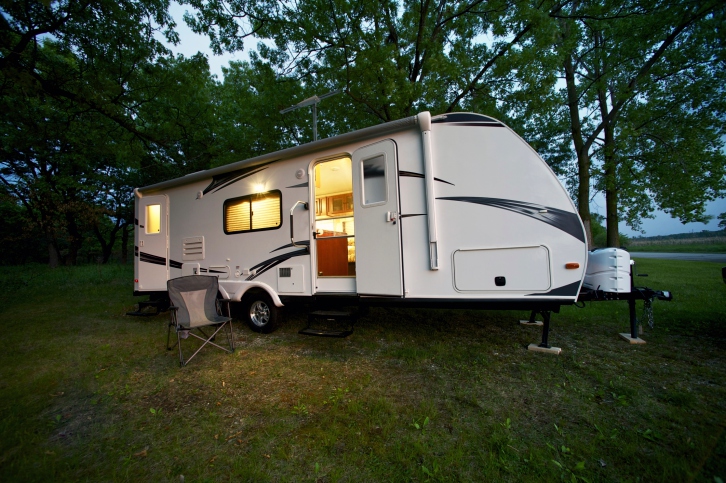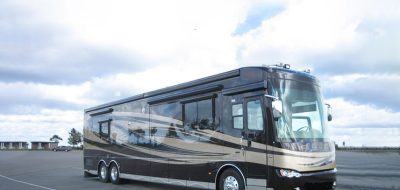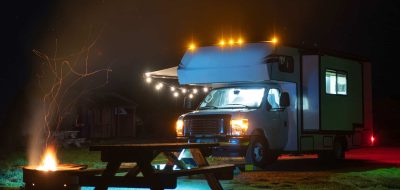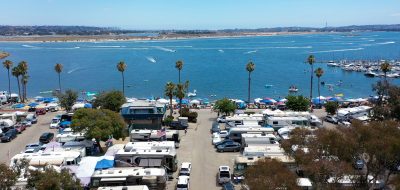 Hi folks! The dog days of summer are here! It’s a good time to seek out cooler climes in your RV. This month, we’ll talk about propane, batteries, tires, and dry camping. Remember to submit your RVing questions to [email protected].
Hi folks! The dog days of summer are here! It’s a good time to seek out cooler climes in your RV. This month, we’ll talk about propane, batteries, tires, and dry camping. Remember to submit your RVing questions to [email protected].
—————————————–
Hi, Mark,
We just bought a new TT that has a outlet for a quick connect propane hose in the back. We’ve been using a Coleman table top grill that uses the disposable 1 pound tanks. I’d like to be able to connect my grill to the TT quick connect gas outlet. However, I’ve been told that this might be a problem because my grill runs off of high pressure and the TT outlet provides low pressure. Is there a way to get around this problem? Thanks, Jeff
Hi, Jeff,
Yes, the two aren’t compatible: your grill is set up for unregulated propane (hi pressure) from a portable cylinder, and the RV propane system is already regulated down to 11” water column pressure (low pressure). There is no cheap and easy way to get around this. However, if you are willing to invest a few dollars and some wrench time, you can install an accessory to “tee” hi pressure propane off at your main tank and run a separate hose that will properly run your portable grill. For a travel trailer, this is the kit you’ll need: //www.rvwholesalers.com/parts/products/flow-longer-plus-propane-adapter-kit-wbrass-elbow-66-9357
Similar kits are available for motorhomes with a different tank adapter that is designed for inline installation to a frame-mounted propane tank: //www.rvwholesalers.com/parts/products/sturgi-flow-66-7096
————————————————-
Mark:
On my new Itasca Navion, the air stem on the inside back dual wheel makes it almost impossible to check the air pressure. An easy fix was to get a four inch steel extension and screw into the inside stem. However, I have read conflicting reports on a number of forums about this creating a problem and the only fix is spending hundreds of dollars changing out the original stems. Can you shed some light onto the real issues? And is there any real reason that the extenders are dangerous? Steven
Hi, Steven,
I am not a big fan of valve extenders, only because they provide another potential leak point. The short metal extenders are usually OK, provided that they are attached only to steel valve stems. Rubber stems are a no-go, due to the flexing the extenders can cause as the wheel rolls. I have had bad luck with the hose-type extenders, and after 2 flat inner tires, I am not a fan. Some folks run them for years without problems, but others have had problems with leaks. I wrestled with the same issues on my rig, and an engineer friend of mine pointed me at a solution that the truckers have been using for years: the Crossfire Dual Tire Pressure Equalization System. The system mounts on the wheel hub or wheel lug and interconnects the two wheels with stainless steel braided hoses. Not only does it equalize the pressure between wheels, so that both tires are inflated to the same pressure, it also provides an easily-accessible single point to add air. Better yet, there is an easily-visible gauge that will tell you at a glance if both tires are correctly inflated! No more knee time! You can read more about the system at //dualdynamics.com/products/cross-fire. When you order them, you will need to specify the pressure you want to run in your tires, and they will send you a system calibrated for that pressure. Different length hoses are available to accommodate different wheel diameters.
————————————————–
Mark:
We have a new 5th wheel and we are thinking about doing some camping with no electricity for several nights. It is a marine battery. I was wondering how long the battery would hold a charge running just the fridge on propane. Also the built-in stereo would draw power even though it is not turned on. Do you know off hand if it is on a separate breaker? How many watts would the refrigerator draw? Thank you, Blair
Hi, Blair,
A typical RV fridge running on propane draws less than 1 amp while in operation, so a single deep cycle battery in good health will not have any trouble supporting it for several days. Built-in stereos do draw a small amount of power to keep their memory alive, but it is usually measured in the milliamps, again, no big deal. Incandescent lights draw 1-2 amps per bulb, so using lights sparingly will reduce power consumption. Fans, like exhaust fans and powered vents, draw anywhere from 1-5 amps, depending on how big they are, so again, watch your usage. Most basic RVs do fine on a single battery until you get into cold weather and need to run your furnace. RV furnaces draw 5-7 amps when operating, and running a furnace all night can exhaust a single battery. If you like to dry camp, 12 volt LED light bulbs are a great upgrade, as they draw about 1/10 the power of a typical incandescent bulb to provide the same amount of light. If you find a single battery is not meeting your needs, most RV battery compartments are big enough to accept a second battery, wired in parallel to the existing one. This will double your capacity. Successful dry camping depends on managing your energy usage, regardless of how many batteries you may have.
——————————————————
Hi, Mark,
I went to use my gas hot water heater in my 2013 Big Country and it would not work. I tried using a metal hanger in the small and large gas tube but neither worked. I get the clicking noise but no luck. I changed the tanks to a full one to see if that would work, no luck. What else can I do? I don’t smell any propane at all. Gus
Hi, Gus,
There are several things to check. The first thing is to verify that you are getting propane to the appliances. Test a stove burner or the fridge to verify that gas is flowing from the tank. If propane is reaching the other appliances, then either the water heater is not flowing propane to the burner, or the gas is flowing, but the heater is not successfully lighting it. Since you hear clicking when it tries to light, that would usually mean that the igniter circuit is making a spark. Since you smell no propane, it is probably a gas flow problem. The gas valve in your water heater operates on 12V DC, and is opened and closed by the circuit board in the water heater. The valve might be defective, or simply stuck closed, or the orifice may be plugged. It may also be a problem with the control board. If you have a meter, test for 12V on the wires to the gas valve during the lighting cycle. If 12V is appearing on those wires, but the valve is not opening, the problem is in the gas valve itself. Cleaning the burner tube and the orifice may get it going. Tapping on the body of a stuck valve may free it. If none of that helps, you will probably need to replace that valve. If there is no 12V going to the valve, it may be a problem with the circuit board, or the wiring. Visually inspect all the wires and connectors. To test the circuit board, most RV shops simply swap in a new board to see if it helps, but you probably don’t have a spare on hand. Once you reach this point, it may be time to have a repair shop look at it if you can’t find an obvious problem. Ordering a new board is also an option, but no guarantees that it will fix the problem. I hope that helps!
——————————————–
Mark,
We have a 1989 Sandpiper travel trailer that runs fine on 110AC but even with new batteries will suddenly no longer run on 12V, although it did when we first bought it a few years back. I’ve pulled and checked all the fuses from the fuse box and they are fine. Is there another connection, switch, or breaker I need to find that may cause this, or is there a method to probing for the issue? Thanks, Dave
Hi, David,
Since your 12V system is not working, let’s start with the battery. Unplug the RV from shore power, and using a voltmeter, measure the voltage at the battery terminals. A fully charged battery normally reads 12.5 volts or above.
- If the battery shows no voltage, check to see that the water levels in the battery are normal, and add distilled water if needed. If the battery was completely dry, it’s time for a new battery! Now, disconnect the battery wiring, marking the cables so you can correctly re-attach them, and recharge the battery (or batteries) with a 12V automotive battery charger. Once it is reading fully charged, reconnect it and check your RV to see if you have 12V power. If the RV 12V lights and fans are working now, then the converter is not charging your battery, and should be tested. If you still don’t have 12v power inside, then proceed as detailed in # 2 below.
- If the battery reads OK, but power from the battery is not reaching the 12V devices inside the RV, there is a wiring or connection problem. Visually inspect all the cables for cleanliness and tightness. Follow the positive cable that leads from the battery to the RV. Does the cable connect to a small box and then continue on to the RV? These small devices are circuit breakers, and they are commonly used on RVs. They are supposed to be self-resetting, but sometimes they fail in the open position. If you have 12V on the circuit breaker input lug and nothing on the output lug, that is your problem. Replace the breaker with one that has the same rating. If the breaker is OK, then the problem is further in, and this may be the point where you should call in a service tech. However, if you want to troubleshoot it yourself, it’s simply a matter of tracing the wiring and finding the point at which the 12V stops. It may be a bad connection, a broken wire, or a problem with your RV converter or a transfer switch.
Most 12V problems are due to loose connections, so that’s the first thing to eliminate. Don’t proceed with troubleshooting past the point where you feel comfortable. That’s what RV repair shops are for.
Do you have a question for Mark? Please submit your question via email to [email protected].
Please remember, material will be edited. Because of the large volume of material and correspondence submitted, individual replies will be limited to questions that are chosen for publication.
Founded in 1978, the Escapees RV Club provides a total support network for RVers that includes a wide variety of opportunities for fun, adventure, and education.
MAIL SERVICE The best mail–forwarding service in the country. Members can personalize their mail delivery receiving only the mail they want when they want. MAGAZINE Award-winning magazine written for RVers by RVers.
CHAPTERS There are 51 chapters across the U.S., Canada, and Mexico that offer local luncheons and rallies within 150 miles of home.
HOPs Theme–related outings and adventures held across the country.
ESCAPADES Five–day educational events that offer over 60 seminars and workshops to educate, entertain, and enhance the RV lifestyle.
PARKS Our discount park system offers a variety parking options. PLUS MUCH MORE!
A complete listing of all Escapees events and a comprehensive list of member benefits are found at www.escapees.com.











